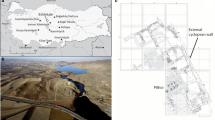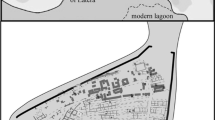Abstract
This paper reports the archaeobotanical data from the so-called Vasca Ducale (Ducal Pit), a brick rubbish pit discovered in the basal floor of the ducal palace of Ferrara, Emilia-Romagna, northern Italy. It was in use during the second half of the 15th century a.d. when the rich and powerful Este family inhabited the palace. Therefore, the results help to investigate the eating customs of a Renaissance court. The pit fill largely consisted of zoological remains, especially small bones and shellfish, with mainly waterlogged plant remains and some artefacts. Though the seed/fruit concentration was not high, a long list of taxa was identified of which the largest part belonged to food and ornamental plants. The data suggest that the pit was used for the disposal of dining waste and floor sweepings. The archaeobotanical data are compared with those obtained from other medieval sites in the city, and with two Renaissance sources of documentary evidence, the frescos in the Salone dei Mesi (Room of the months) in Ferrara’s Palazzo Schifanoia, and the cookbook by Cristoforo da Messisbugo, chef at the Este court. The archaeobotanical record of the Vasca Ducale (Ducal Pit) proved to be quite different from the other sites in Ferrara, especially because of the presence of luxury or exotic foods such as, for example, Punica granatum, Prunus armeniaca and Coriandrum sativum.





Similar content being viewed by others
References
Alessandrini A, Bonafede F (1996) Atlante della Flora protetta della Regione Emilia Romagna. Regione Emilia Romagna, Bologna
Bakels CC, Jacomet S (2003) Access to luxury foods in central Europe during the Roman period: the archaeobotanical evidence. World Archaeol 34:542–557
Bandini F (ed) (1992) Cristoforo da Messisbugo. Banchetti composizioni di vivande e apparecchio generale (1549). Neri Pozza Editore, Vicenza
Bandini Mazzanti M, Accorsi CA, Forlani L, Marchesini M, Torri P (1992) Semi e frutti dalla Ferrara basso medioevale. In: Gelichi S (ed) Ferrara prima e dopo il Castello. Spazio Libri Editori, Ferrara, pp 118–137
Bandini Mazzanti M, Mercuri AM, Trevisan Grandi G, Barbi M, Accorsi CA (1999) Il fossato di Argenta (Ferrara) e la sua bonifica in età medievale: contributo alla ricostruzione della storia del sito in base ai semi e frutti del riempimento. In: Guarnieri C (ed) Il Tardo Medioevo ad Argenta: lo scavo di via Vinarola-Aleotti. (Quaderni di archeologia dell’Emilia Romagna 2) All’Insegna del Giglio, Firenze, pp 219–237
Bandini Mazzanti M, Marchesini M, Marvelli S, Bosi G, Mercuri AM, Accorsi CA (2002) Semi e frutti del pozzo di Cognento (Modena) dal periodo tardo romano all’età moderna. In: Marini Calvani M (ed) Archeologia dell’Emilia Romagna 1999 III. All’Insegna del Giglio, Firenze, pp 207–228
Bandini Mazzanti M, Bosi G, Mercuri AM, Accorsi CA, Guarnieri C (2005) Plant use in a city in Northern Italy during the Late Mediaeval and Renaissance periods: results of the archaeobotanical investigation of ‘The Mirror Pit’ (14th–15th century a.d.) in Ferrara. Veg Hist Archaeobot 14:442–452
Bandini Mazzanti M, Bosi G, Romagnoli C (2006) Semi e frutti in boccali del monastero benedettino di S. Antonio in Polesine: indizi di antiche preparazioni officinali? In: Guarnieri C (ed) S. Antonio in Polesine: archeologia e storia di un monastero estense. (Quaderni di Archeologia dell’Emilia Romagna 12) All’Insegna del Giglio, Firenze, pp 301–308
Behre K-E (1999) The history of beer additives in Europe—a review. Veg Hist Archaeobot 8:35–48
Bosi G (2000) Flora e ambiente vegetale a Ferrara tra il X e il XV secolo attraverso i reperti carpologici dello scavo di Corso Porta Reno—Via Vaspergolo nell’attuale centro storico. Doctoral Thesis, Università degli Studi di Firenze
Bosi G, Accorsi CA (2007) Analisi dei microcarboni nel sito di Jure Vetere Sottano prima e durante la vita del monastero medievale. In: Fonseca C, Roubis D, Sogliano F (eds) Jure Vetere. Ricerche archeologiche nella prima fondazione monastica di Giocchino da Fiore (indagini 2001–2005) Rubettino Editore, Soveria Mannelli (CZ), pp 269–272
Bosi G, Bandini Mazzanti M (2006) Lo spettro carpologico del vano sotterraneo di scarico USM5 del monastero di S. Antonio in Polesine: qualche notizia botanica sulla dieta bassomedievale e sull’assetto degli spazi interni. In: Guarnieri C (ed) S. Antonio in Polesine: archeologia e storia di un monastero estense. (Quaderni di Archeologia dell’Emilia Romagna 12) All’Insegna del Giglio, Firenze, pp 189–192
Bosi G, Bandini Mazzanti M (2007) Portulaca oleracea L., fra il periodo romano e il Rinascimento in Emilia Romagna: informazioni dai reperti archeocarpologici. Informatore Botanico Italiano 38/1 (dicembre 2006):40–47
Bosi G, Bandini Mazzanti M, Mercuri AM, Torri P, Trevisan Grandi G, Accorsi CA, Guarnieri C, Vallini C, Scafuri F (2006) Il Giardino delle Duchesse del Palazzo Ducale Estense di Ferrara da Ercole I (XV sec.) ad oggi: basi archeobotaniche e storico-archeologiche per la ricostruzione del giardino. In: Morel JP, Tresserras JJ, Matamala JC (eds) The archaeology of crop fields and gardens. EdiPuglia, Bari, pp 103–128
Bosi G, Bandini Mazzanti M, Mercuri AM (2007) Mutina and the plant remains of Roman Age in Emilia Romagna (Italy). In: Bieniek A (ed) 14th symposium of the international work group for palaeoethnobotany. 17–23 Juna 2007, Krakow, Poland. Programme and abstracts, p 123
Botineau M (2003) Les plantes du Jardin Médiéval. Belin, Paris
Calef P (ed) (1997) Ildegarda di Bingen. Cause e cure dell’infermità (XII sec.). Sellerio, Palermo
Cambornac M (1998) Plantes et jardins du Moyen Age. Hartmann Ėdition, Paris
Cappers RTJ (2006) Roman foodprints at Berenike: archaeobotanical evidence of subsistence and trade in the Eastern Desert of Egypt. (Cotsen Institute of Archaeology Monograph 55), University of California, Los Angeles
Castelletti L, Castiglioni E, Rottoli M (2001) L’agricoltura dell’Italia settentrionale dal Neolitico al Medioevo. In: Failla O, Forni G (eds) Le piante coltivate e la loro storia. FrancoAngeli, Milano, pp 33–84
Danin A, Baker I, Baker HG (1978) Cytogeography and taxonomy of the Portulaca oleracea L. polyploid complex. Isr J Bot 27:177–211
Ernst M, Jacomet S (2006) The value of the archaeobotanical analysis of desiccated plant remains from old buildings: methodological aspects and interpretation of crop weed assemblages. Veg Hist Archaeobot 15:45–56
Forlani L, Accorsi CA, Bandini Mazzanti M, Marchesini M, Bandieri R (1992) Legni e carboni dalla Ferrara basso medioevale (Emilia Romagna—nord Italia). In: Gelichi S (ed) Ferrara prima e dopo il Castello. Spazio Libri Editori, Ferrara, pp 138–151
Frank KS, Stika HP (1988) Bearbeitung der makroskopischen Pflanzen- und einiger Tierreste des Römerkastells Sablonetum (Ellingen bei Weissenburg in Bayern). (Materialhefte zur bayerischen Vorgeschichte A61) Laßleben, Kallmünz
Gaia T, Soracco D (2007) Guida agli extravergini. Slow Food Editore, Bra (CN)
Grieco AJ (2003) Alimentazione e classi sociali nel tardo Medioevo a nel Rinascimento in Italia. In: Flandrin JL, Montanari M (eds) Storia dell’alimentazione. Editori Laterza, Bari, pp 371–380
Guarnieri C (2006) Il vano sotterraneo USM 5: alcune considerazioni sulla tipologia dei materiali. In: Guarnieri C (ed) S. Antonio in Polesine: archeologia e storia di un monastero estense. (Quaderni di Archeologia dell’Emilia Romagna 12) All’Insegna del Giglio, Firenze, pp 135–141
Guioli S, Campanini F (2007) I molluschi della vasca di scarico del Palazzo Ducale di Ferrara. Bollettino Malacologico 43:156–160
Harlan JR (1975) Crops and man. American Society of Agronomy, Madison
Hastorf CA (1999) Recent research in Paleoethnobotany. J Archaeol Res 7:55–103
Hehn V (1870) Kulturpflanzen und Haustiere in ihrem Übergang aus Asien nach Griechenland und Italien so wie in das übrige Europa. Historische-linguistische Skizzen. Berlin, p 456
Hellwig M (1997) Plant remains from two cesspits (15th and 16th century) and a pond (13th century) from Göttingen, southern Lower Saxony, Germany. Veg Hist Archaeobot 6:105–116
Judd WS, Campbell CS, Kellog EA, Stevens PF, Donoghue MJ (2002) Plant systematics: a phylogenetic approach. Sinauer Associates, Sunderland (USA)
Landsberg S (2005) The medieval garden. The British Museum Press, London
Lepofsky D, Kirch PV, Lertzman KP (1998) Metric analyses of prehistoric morphological change in cultivated fruits and nuts: an example from Island Melanesia. J Archaeol Sci 25:1001–1014
Lieutaghi P (1992) Jardins des savoirs, Jardins d’histoire. Les Alpes de Lumière, Marseille
Livarda A, Van der Veen M (2008) Social access and dispersal of condiments in North-West Europe from the Roman to the medieval period. Veg Hist Archaeobot 17(Suppl 1):S201–S209
Martinez JJ, Melgarejo P, Hernandez F, Salazar DM, Martinez R (2006) Seed characterisation of five new pomegranate (Punica granatum L.) varieties. Scientia Horticolturae 110:241–246
Matthioli MPA (1559) I discorsi di M. Pietro Andrea Matthioli, medico sanese, nei sei libri di Pedacio Dioscoride Anazarbeo, della materia medicinale (held in the library of the Department of Natural and Cultural Resources of the Univeristy of Ferrara)
Mercuri AM, Trevisan Grandi G, Bandini Mazzanti M, Barbi M, Accorsi CA (1999) I semi/frutti della latrina del Monastero di S. Caterina. In: Guarnieri C (ed) Il Tardo Medioevo ad Argenta: lo scavo di via Vinarola-Aleotti. (Quaderni di archeologia dell’Emilia Romagna 2) All’Insegna del Giglio, Firenze, pp 238–245
Mercuri AM, Accorsi CA, Bandini Mazzanti M, Bosi G, Trevisan Grandi G (2007) Il paesaggio vegetale di Jure Vetere prima e durante la vita del monastero medievale sulla base dei primi dati pollinici. In: Fonseca C, Roubis D, Sogliano F (eds) Jure Vetere. Ricerche archeologiche nella prima fondazione monastica di Giocchino da Fiore (indagini 2001–2005). Rubettino Editore, Soveria Mannelli (CZ), pp 249–267
Nisbet R, Rottoli M (2000) Agricoltura e consumo delle piante al Castello della Motta. In: Piuzzi F (ed) L’incastellamento nel nord-est italiano (IX-XII secolo). Stato della ricerca e prospettive d’indagine. (Quaderni Museo Archeologico Medioevale di Attimis 2) Udine, pp 93–98
Palmer C, Van der Veen M (2002) Archaeobotany and the social context of food. Acta Palaeobot 42:195–202
Pennington HL, Weber SA (2004) Paleoethnobotany: modern research connecting ancient plants and ancient peoples. Crit Rev Plant Sci 23:13–20
Picchi G, Pieroni A (2005) Le Erbe. Agra/Rai Eri, Roma
Piccoli F (1989) La flora. In: Varese R (ed) Atlante di Schifanoia. Edizioni Panini, Modena, pp 213–215
Piccoli F (2000) Flora e vegetazione della bassa pianura emiliana e romagnola. In: Ferrari C, Gambi L (eds) Un Po di terra. Guida all’ambiente della Bassa Pianura Padana e alla sua storia. Diabasis, Reggio Emilia, pp 93–108
Pignatti S (1982) Flora d’Italia—I-II-III. Edagricole, Bologna
Pignotti L (1998) Revisione sistematica dei generi Scirpus L. Sect. Plur. (Bolboscoenus, Schoenoplectus, Actaegeton, Isolepis, Eleogiton) e Blysmus Panz. (CYPERACEAE) in Italia. Doctoral Thesis, Università degli Studi di Firenze
Renfrew JM (1973) Paleoethnobotany. Methuen, London
Revedin P (1909) Contributo alla flora vascolare della provincia di Ferrara. Nuovo Giornale Botanico Italiano 16(Nuova serie):269–333
Scortichini M (1990) Frutti da riscoprire. Edizioni Agricole, Bologna
Segre Rutz V (ed) (2004) Historia Plantarum, ms. 459, Biblioteca Casanatense, Roma (XIV cent.). Franco Cosimo Panini Editore, Modena
Spjut RW (1994) A systematic treatment of fruit types. Memoirs NY Bot Gard 70:1–182
Tutin TG et al (1964–93) Flora Europaea, vol 1 (1964); vol 2 (1968); vol 3 (1972); vol 4 (1976); vol 5 (1980) vol 1 (2th edn - 1993). Cambridge University Press, Cambridge
Van der Veen M (2003) When is food a luxury? World Archaeol 34:405–427
Van Wyk BE (2005) Food plants of the world. Timber Press, Portland, p 152
Yarnell RA (1978) Domestication of sunflower and sumpweed in eastern North America. In: Ford RI (ed) The nature and status of ethnobotany. Museum of Anthropology, University of Michigan
Zama B (1999/2000) Manufatti lignei del sito archeologico di via Vaspergolo—corso Porta Reno (Ferrara—Nord Italia) datato X-XV sec. d.C. Analisi xilologiche e considerazione di ordine etnobotanico e floristico-vegetazionale. Thesis, Università di Bologna
Zohary D, Hopf M (1994) Domestication of the plants in the old world. Clarendon Press, Oxford
Acknowledgments
Financial support was partly provided by PaCE—EU Programme ‘Culture 2000’ (CLT2007/1.2.1/IT-182—Plants and Culture: Seeds of the Cultural Heritage of Europe, coordinator Anna Maria Mercuri).
Author information
Authors and Affiliations
Corresponding author
Additional information
Communicated by S. Jacomet.
Rights and permissions
About this article
Cite this article
Bosi, G., Mercuri, A.M., Guarnieri, C. et al. Luxury food and ornamental plants at the 15th century a.d. Renaissance court of the Este family (Ferrara, northern Italy). Veget Hist Archaeobot 18, 389–402 (2009). https://doi.org/10.1007/s00334-009-0220-z
Received:
Accepted:
Published:
Issue Date:
DOI: https://doi.org/10.1007/s00334-009-0220-z




